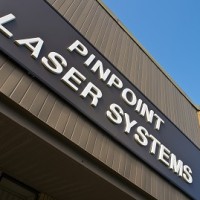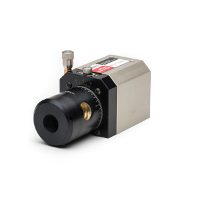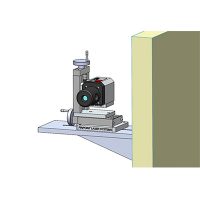ROI
App Chat
Free Report
Notes
Tips
FAQ
Videos
Laser Alignment Terminology
A short glossary of laser alignment terms to help meet your needs.
Our engineers have compiled a short glossary of laser alignment terms to help you better understand how our products can meet the needs of your company. Feel free to use the search function at the top of the site at any point to find what you’re looking for.
- Accuracy
- Accuracy is the ability of a measuring device or instrument to provide repeatable or precise measuring values to a known standard or constant value. This term is sometimes confused with “precision” or “repeatability”. A simple analogy that we like to refer to here at Pinpoint is the case of a marksman shooting at a distant target. If this marksman can shoot 10 arrows and they are all clustered together in the center of the target, where he was aiming, his results are accurate. If the ten arrows are clustered together but not at the center of the target the results are said to be “repeatable” or “precise”.
- Air Turbulence
- Air, moving around a measurement site, creates regions of turbulence with high and low pressure cells. These are momentary in nature because the high and low pressure tends to seek equilibrium. A ray of light or a laser beam can be refracted as it passes through a region of high or low pressure because the increased density of the medium that the laser or light travels through. A very extreme example of this is the way in which water in a pond distorts the location of a stick or object below the water’s surface. On a minute scale, small moving air pressure gradients refract the path of a laser beam so over long measuring runs with a laser beam the measurement values appear to move. Our Pinpoint Microgage products all come with a digital averaging function that allows you to “average out” this noise and obtain accurate readings.
- Arc-minute
- A measure of angle equivalent to 1/60 of a degree or 0.01666 degrees.
- Arc-second
- A measure of angle corresponding to 1/3600 of a degree or 0.00028 degrees. A degree of angle can be subdivided into 60 parts called minutes. Each minute of arc can be further sub-divided into 60 parts called arc-seconds.
- Alignment
- The process or science of orienting machinery, machine alignment – or equipment so it is positioned and spatially oriented to other machinery or sub-assemblies relative to defined features or datums.
- Angular Error
- This is an alignment error that is angular in nature and tends to change with distance traveled. For example, if a moving machine bed travels 60 inches and its surface rises steadily in height as it travels on a horizontal plane it is said to have an angular error. As the distance between two aligned elements increases the magnitude of the angular error will typically increase as well.
- Averaging Interval
- If data readings are being collected and averaged, the averaging interval is the time period during which a sample of readings are taken and then averaged.
- Axial
- A term referring to an axis of motion, movement or alignment.
- Backlash
- A relative movement between interacting mechanical parts, resulting from looseness.
- Beam Diameter
- The diameter of a laser beam typically given in millimeters.
- Beam Divergence
- The symmetrical expansion of a laser beam’s cross section as it moves through space. The rays or a laser beam passing through air or a similar medium are not absolutely parallel but tend to diverge very slightly. This may be caused by highly microscopic variations in the optics which the laser is passing through or perhaps variations in air density as the laser beam travels along. Beam Divergence is typically measured in milli-radian units shown as mrad. Pinpoint Microgage products work accurately despite divergence in the laser reference beam.
- Buck In
- A process of aligning a measuring system to several reference datums. For example, if one is measuring the flatness of a machined surface, a laser system could be adjusted or “bucked in” so that the measurement readings at three distinct points on the machine surface are equal to one another. In this way, all subsequent readings are relative to the plane defined by these three reference points on the machined surface. A straight line can be bucked in with only two reference points.
- Buttock Line
- This is a term typically used in the aircraft industry to describe a reference line that runs lengthwise from the front to the rear of the aircraft.
- Bubble Level
- A precision leveling instrument consisting of a tube, filled with a liquid, and a trapped bubble of air. As the tube is positioned so its surface is perpendicular to gravity the bubble will center itself between a series of reference lines. The accuracy of a bubble level is typically expressed in fractions of an angle, for example; 10 arc-second bubble level. The bubble levels used on Pinpoint products are equivalent to or better than those used on precision machinist’s levels.
- Calibration
- In accordance to VIM: “Calibration is the operation that, under specified conditions, establishes a relationship between the quantity values with measurement uncertainties provided by measurement standards and corresponding indications with measurement uncertainties.”
- Calibrating is measuring and comparing data, which is why often the term indicates actual adjusting to reach precision alignment.
- Catenary
- A curve formed by a flexible string, wire, band or assembly suspended between two spatially-separated points of equal height in a gravitational field. The form of the curve is determined primarily by the tension in the suspended element and it’s mass per unit length.
- Clinometer
- See level or bubble level.
- Coincidence Level
- A high accuracy bubble level where a prism is mounted above the bubble level tube to simultaneously image both ends of the floating bubble. This device allows users see the bubble with greater accuracy and precision for more precise leveling measurements.
- Co-linear
- Parallel to or falling on a single straight datum line.
- Concentric
- Having a common center.
- Cosine Error
- The measurement error in the motion direction caused by an angular misalignment between a linear displacement measuring system and the gage or displacement being measured.
- Crosstalk
- A measurable leakage of optical or electrical energy from one conductor to another, also known as coupling.
- Datum Point
- A reference point that has a position that is used for measuring, alignment and calculations.
- Datum Line
- A reference line that has a position that is used for measuring, alignment and calculations.
- Datum Plane
- A theoretical plane defined by three datum points used for measuring, alignment and calculations.
- Diode Laser
- An electronic, semiconductor device that generates a laser light source. All Pinpoint products use diode lasers because they are sturdy, robust and work very well for industrial measuring applications.
- Drift
- The gradual change in the output of a measuring device over time.
- Filter
- A term with many meanings but for measuring and alignment applications is typically associated with averaging or data processing techniques to reduce the influence of unwanted vibration, air turbulence and other noise sources from measuring data.
- Flatness
- A surface in which all the points lie in a common plane. Often referred to as smooth or flat. Note flat plane does not need to be level to gravity in order to be flat.
- Harmonic Oscillation
- A state where a surface, structure or an element of a machine may be vibrating with a specific set of amplitudes and frequencies. This gives rise to a small and often fast moving displacement of the surface which might introduce slight measuring errors.
- He/Ne Laser
- A laser source that employs a tube filled with helium and neon gas that generates a specific wavelength of light at 632.8 Nanometers. These lasers have been popular in the past for measuring systems but require significant power supplies and thermal stability to operate correctly and lack the robustness of newer diode lasers for tough industrial applications.
- Hysteresis
- an error component of bi-directional repeatability caused by mechanisms such as drive train clearance, guideway clearance, mechanical deformations, friction and loose joints.
- Interferometer
- A measuring device that uses the interference of light waves, typically from a laser, to measure the distance or linear position of a machine tool’s axis. Position or displacement is measured in wavelength or fraction of a wavelength units for very precise and accurate measurements.
- Laser Classification
- A system of categorizing laser devices, primarily for safety considerations, based upon their output power, wavelength and cycling time. Within the United States, information on Laser Classification is maintained and coordinated by the Center for Devices & Radiological Health (CDRH) which is affiliated with the Food and Drug Administration. All Pinpoint Lasers are class IIIa or class II laser devices – equivalent in power and wavelength to the type of lasers found in standard laser pointers.
- Laser Diode
- see Diode Laser
- Lateral Axis
- A measuring axis, common on Pinpoint products, where the measurement is made across the centerline or longitudinal axis of a laser reference beam. The lateral axis can include measurements that might be up or down or perhaps left or right across the laser beam.
- Level
- A state of position or alignment where a plane or line is square to the local gravitational field vector, i.e. gravity. The instrument for measuring level is called; a level or a clinometer.
- Longitudinal Axis
- An axis, common on Pinpoint products, where the laser beam is located as a datum or reference line for measuring and alignment. For example, the longitudinal axis may be oriented through the center of a bore tube and measurements made laterally to determine if the elements of the bore are all equidistant from this center datum line.
- Machine Coordinate System
- The coordinate system which corresponds to the axes of a machine on which a part is to be manufactured. The coordinate system usually includes one or more linear axes designated as X, Y or Z. The machine may also include rotary axes usually designated as A, B and C.
- Milliradian
- A unit of angular measurement that is equivalent to 1/1000 of a radian or 0.0573 degrees.
- Monochromatic
- An optical term meaning of one color or wavelength. A laser is said to be monochromatic because the light is of nearly one wavelength or color.
- Normalize
- A term with two typical meanings for measuring and alignment applications; to bring to a common temperature and to compute data results into a common mathematical framework. For temperature, normalizing is the process of allowing a machine or assembly to reach a consistent temperature throughout. For analyzing measuring results Normalizing is the process of connecting the various readings, through calculations, to a common reference or datum set.
- Offset
- A mechanical or measurement spacing between series of measurements. For example, if one is measuring the straightness of two parallel edges on an assembly the first set of readings for the first edge might be 2 inches above the second edge. Adding an offset lets you directly compare the readings for both edges.
- Parallelism
- The condition of a surface, a line or axis that is equidistant at all points from a datum plane or axis.
- Pentaprism
- A five-sided optical prism that has two reflecting surfaces that are 45 degrees to one another. The beam of laser light exiting the pentaprism is always precisely square to the laser beam entering the pentaprism. A pentaprism may also be called an “optical square” for machinery alignment.
- Perpendicularity
- The condition of a surface, a line or axis that is 90 degrees at all points from a datum plane or axis.
- Pi Tape
- A precisely ruled tape measure that is typically wrapped around rolls or large cylindrical objects to determine their diameter or the distance between them for alignment purposes.
- Pitch
- The angular motion of a carriage or assembly, designed for linear motion, about an axis perpendicular to the motion direction and perpendicular to the yaw axis. A linear coordinate system is typically defined with an X, Y and Z axis and the corresponding angular axes for these three are pitch, yaw and roll, respectively.
- Pitch Axis
- Pinpoint offers a 4 Axis Precision Mount that supports the laser transmitter and moves the laser reference beam up and down as well as left and right. The Pitch Axis is the angular swing component of the up/down linear positioning for the laser beam.
- Plane
- A surface that has no curvature; a surface that is perfectly flat.
- Play
- A condition of low or zero stiffness over a limited range of displacement due to clearance between members of a structural assembly.
- Polarity
- A term used on Pinpoint products to denote the direction of measurement values for a given motion. Typically, if a laser reference beam moves across a receiver surface from a zero location in an upwards direction the measuring values will be positive and increasing. A change in the polarity setting will reverse this or provide options to move the zero point location.
- Pointing Accuracy
- Pointing accuracy refers to the accuracy of the laser reference beam’s position relative to an absolute theoretical center location along the laser beam path. This center position is typically defined by the flat machined sides and base of the laser housing. The pointing accuracy is a very small value that describes the center position of the laser beam relative to the theoretical position of the laser beam. Please contact Pinpoint for details on this accuracy value and its significance for your application.
- Pointing Stability
- Given a slight pointing error in a laser source, pointing stability refers to the consistency of this error and if the error changes over time.
- Precision
- Precision and repeatability are both terms that refer to the dispersion or variability of measurement readings in a stable, unchanging environment. A simple analogy that we like to refer to here at Pinpoint is the case of a marksman shooting at a distant target. If this marksman can shoot 10 arrows and they are all closely clustered together his ability to aim arrows is precise and repeatable. If the ten arrows are not only clustered closely together but also at the center of the target, where he was aiming, the results are said to be accurate. If a machine tool returns to its home position many times and the same X,Y and Z values are observed – the machine is repeatable and precise. If the home position values are at the exact intended locations the machine is said to be not only repeatable and precise but also accurate.
- Radian
- A natural unit of angle. For small angles, the radian is often represented by “rise over run”. Radians can be converted to degrees by multiplying by 57.29 or to arc-seconds by multiplying by 206,265. A milliradian (mrad) is a thousandth of a radian and a microradian (urad) is a millionth of a radian.
- Reference Surfaces
- Lasers, receivers and alignment accessories typically have designated reference surfaces on the exterior of the laser housing. These surfaces are used for mounting the device so that the laser is projected from a known location or the receiver is placed in the correct position to accept the laser reference beam.
- Reference Points
- Fixturing for laser alignment systems may have reference points that serve to locate the fixture in the correct position or orientation. These points might be locating flats, bushings for locating pins, monuments, tapped holes or other configurations.
- Repeatability
- See precision
- Resolution
- Resolution is the smallest increment of change that a measuring instrument can detect. For example, a micrometer with rulings every 0.001 inch is said to have a resolution of 0.001 inch. On a digital instrument this would be the least significant bit.
- Retroreflector
- An optical device that returns a beam of light on the same angle as the incident beam striking the device. Examples include corner cubes and mirrors set square to the incident beam.
- Roll Axis
- The angular motion about the linear axis of motion or reference. In the case of a laser reference beam, the roll axis would be about the centerline of the projected laser beam. A linear coordinate system is typically defined with an X, Y and Z axis and the corresponding angular axes for these three are pitch, yaw and roll, respectively.
- Roundness
- Roundness is a characteristic that all parts of a circle are identical.
- Runout
- The deviation from the desired form of a part surface during a linear or rotational motion relative to a datum axis. For example, a machine bed moving in the X axis direction may have erroneous motions in the Z and Y axes which are called runout.
- Scale Factor
- A multiplier used in scaling measurement values for various calculations. For example, when converting inches to centimeters a scale factor of 2.54 would be used. Often, scale factors are combined with a constant or offset value for particular data calculations.
- Spindle
- A device which provides an axis of rotation for the purpose of rapidly rotating a part or a tool to provide sufficient surface speed for cutting operations.
- Squareness
- A plane or linear axis is “square” to a datum axis if a 90 degree relationship is maintained between the two. The measure of straightness is the angular deviation from 90 degrees measured between the best fit lines drawn through two sets of data derived from two orthogonal axes in a specified work area.
- Straightness
- Straightness is a measure of the deviation for a fixed surface, feature or a moving system from a straight line or datum axis. A condition in which an element of a surface or axis is a straight line.
- Surface Plate
- The primary purpose of a surface plate is to provide a reference plane for measuring and checking parts. Surface plates may be made of ground steel or similar surfaces but are most commonly made of granite that has been polished to a smooth, flat surface and calibrated.
- Thermal Expansion
- The difference between the length (or volume) of a body at one temperature and its length (or volume) at another temperature is called the linear (or volumetric) thermal expansion of the body.
- Units
- On Pinpoint products, units refer to the unit of measurement, typically inches or decimal fractions of an inch (i.e.; 0.0001 inch, etc.). Units can also be selected for millimeters, centimeters, mils and other units.
- Waterline
- A term used in shipbuilding and aerospace manufacturing to define horizontal reference plane that passes through the ship or aircraft.
- Yaw Axis
- An axis of rotation that is centered around the Z axis or vertical axis of a machine tool. A linear coordinate system is typically defined with an X, Y and Z axis and the corresponding angular axes for these three are pitch, yaw and roll, respectively.
- Zero Set
- A measuring instrument can be set to a zero reference reading with a Zero Set function. This is a convenient way of observing differential changes relative to a reference point. All Pinpoint products have Zero Setting capability.
Terminology
- Accuracy
- Air Turbulence
- Arc-minute
- Arc-second
- Alignment
- Angular Error
- Averaging Interval
- Axial
- Backlash
- Beam Diameter
- Beam Divergence
- Buck In
- Buttock Line
- Bubble Level
- Calibration
- Catenary
- Clinometer
- Coincidence Level
- Co-linear
- Concentric
- Cosine Error
- Crosstalk
- Datum Point
- Datum Line
- Datum Plane
- Diode Laser
- Drift
- Filter
- Flatness
- Harmonic Oscillation
- He/Ne Laser
- Hysteresis
- Interferometer
- Laser Classification
- Laser Diode
- Lateral Axis
- Level
- Longitudinal Axis
- Machine Coordinate System
- Milliradian
- Monochromatic
- Normalize
- Offset
- Parallelism
- Pentaprism
- Perpendicularity
- Pi Tape
- Pitch
- Pitch Axis
- Plane
- Play
- Polarity
- Pointing Accuracy
- Pointing Stability
- Precision
- Radian
- Reference Surfaces
- Reference Points
- Repeatability
- Resolution
- Retroreflector
- Roll Axis
- Roundness
- Runout
- Scale Factor
- Spindle
- Squareness
- Straightness
- Surface Plate
- Thermal Expansion
- Units
- Waterline
- Yaw Axis
- Zero Set
Find your solution here
Not sure which laser alignment product is right for your job? Get expert advice from our engineers, contact us today.
ROI
App Chat
Free Report
Talk to our alignment specialists
News & Information from the Trusted Laser Alignment ExpertsContact Pinpoint Laser Systems
Discuss your application needs with one of our alignment specialists or contact us with any questions you may have. We can be reached at:
(Phone) 978-532-8001 • (Fax) 978-532-8002 • (Email) info@pinpointlaser.comTalk With an Engineer
Chat Now Other Contact Options









